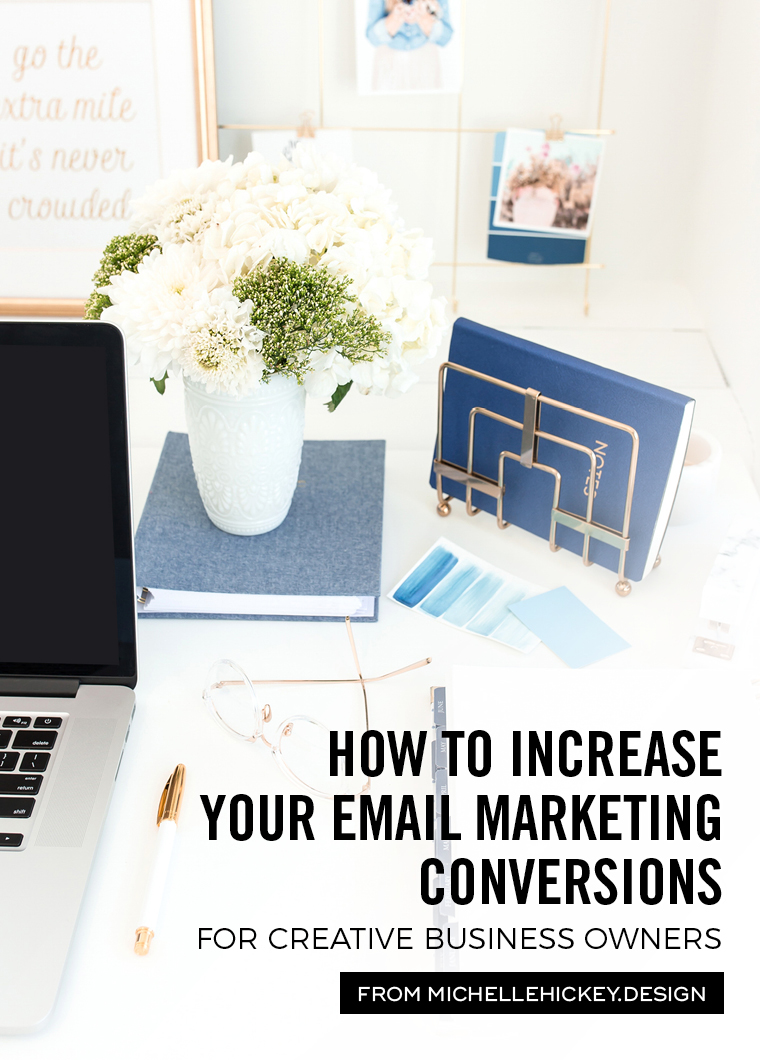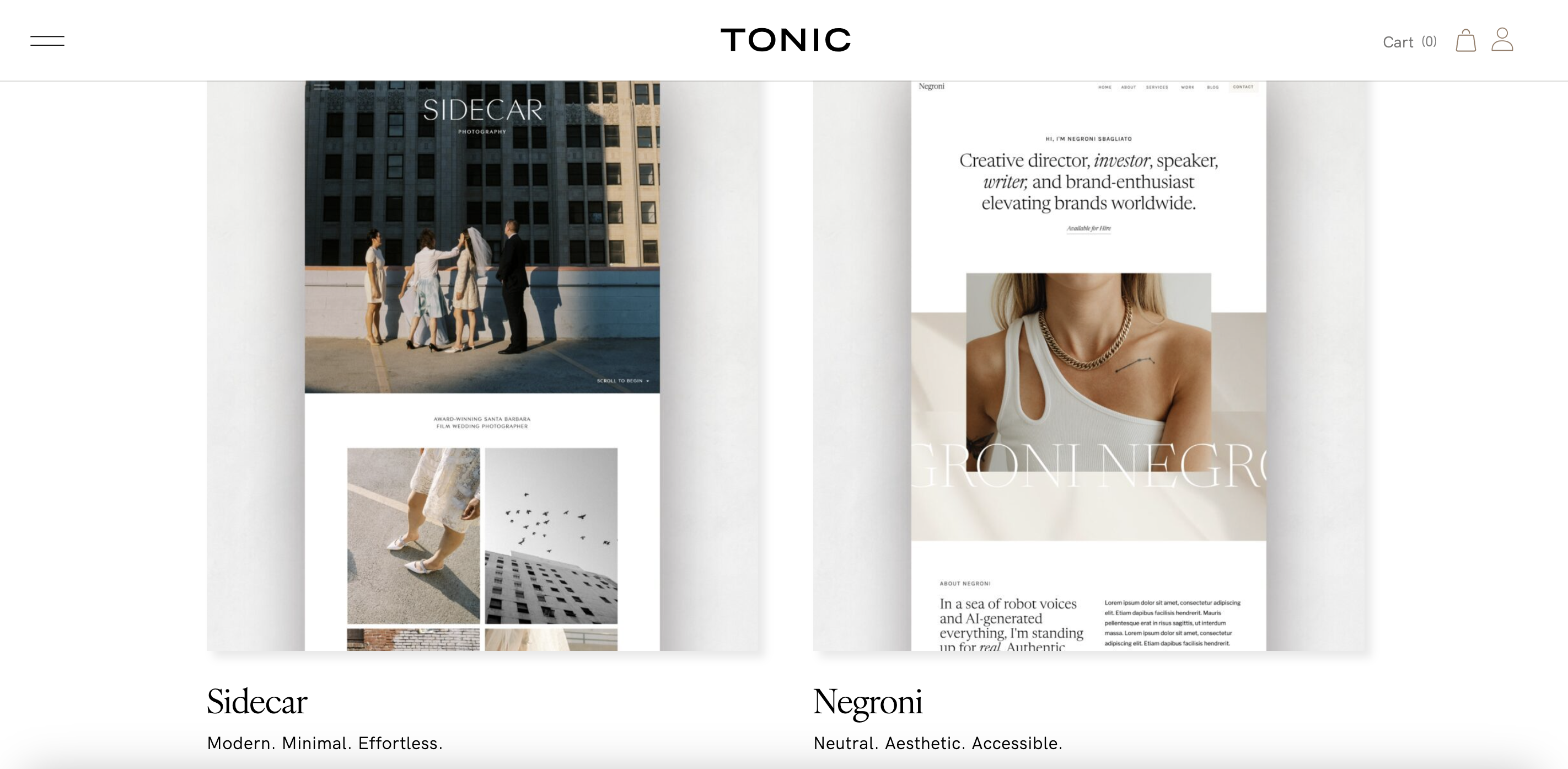Are you a creative business owner who has been struggling with converting email subscribers to buyers and lifelong fans? In this blog post and video, Michelle shares an underutilized strategy that you can use to increase your odds of making a connection.

If you have an online business, you’re probably getting really sick of hearing about “the importance of an email list,” especially if you don’t have one. Even though it is has been statistically proven that email marketing leads to more sales, many of us don’t make the time or effort to get an effective system in place.
If you have any kind of creative business, and you don’t have an email plan, do not feel bad or like you don’t have your act together because the truth is, there are a lot of people who say they “do email marketing,” but they haven’t actually implemented a good strategy— one where they are seeing results.
If you’ve been avoiding email marketing, it’s likely because of one of these reasons:
- Because it feels like it’s technical and complicated and it would take months to understand and implement.
- Because you’ve gotten slimy emails from people who are trying to sell you things, and you don’t want to be that person.
- Or maybe because you have no idea what you would even say, or what you should say, were you to email someone in your audience or a potential customer.
So if you are someone who has been avoiding email marketing altogether, or you’re someone who begrudgingly set up a plan, but hasn’t been following through with it, I want to help you understand the real reason why you need to be email marketing. And show you the one place where you can make an impact.
Automation has its flaws
You may have heard people say that the reason email marketing is so appealing is that once it’s set up, it’s all automated and you’ll never have to talk to anyone. I’m sure you’ve heard reference to the email funnel.
Just sent people through the funnel. They’ll join your list by grabbing your free opt-in, slide on through a series of automated emails, and in the end, they’ll buy your product or service while you lay in a hammock on the beach.
Does this system work? Yes, for a lot of business it does. You can follow that blueprint and make sales. But not every person who goes through that funnel will buy something from you.
In fact, the average conversion rate for an email funnel is 1-5%.
That’s crazy to me. And I had to dig really deep to find that statistic— because nobody wants to talk about it.
Let’s just say you get 100 people to sign up for your free opt-in. Which in itself, is a victory, because nobody likes filling out forms. Statistically speaking, by the time those people go through your email funnel, 95 to 99 of them will have lost interest in you and what you’re selling. WHAT?
I don’t like that. That’s why you need such a large mailing list— because 95-99% of these people aren’t buying from you.
What happens to the people who didn’t buy your product at the end of your funnel? And what happened to the person who stopped opening your emails after the first one or second one?
The power of human connection
I’ve been “doing email marketing” for about three years now, and it only dawned on me recently that we shouldn’t be trying so hard to get more subscribers. We should be figuring out why the people who are opting in, aren’t sticking around or buying from us.
The easy thing to do here is to blame our email subscribers: they’re so cheap, they’re so greedy, they only want free stuff. I’ve heard these comments from friends, colleagues, and I’m embarrassed to say that I’ve had these thoughts myself.
Our email subscribers are not the problem. We are the problem. Something is happening in between the point where they say, “Yes, I want this freebie you have. I will fill out your form. I will even check your GDPR box,” and when they download the opt-in.
That first email to them. The one where they get the freebie. This is our make or break moment. Because the reality is, a lot of people are going to click, take that free download, go away and never open an email from you again.
We need to set a new goal when they get this email. The most valuable thing we can get them to do here is this: respond to us.
For them to turn the tables and write us an email back.
We are in the problem-solving business
A lot of you might be cringing and thinking that this is the worst possible thing that could happen to you. It means another email in your inbox, another person to respond to, and someone else’s problem that you have to solve.
Guys, if you run a business and you want to make money, and you get a response from a subscriber who is willing to tell you what they’re struggling with, you just struck gold. Our jobs are to solve problems and to make life better for people. But we can’t do our jobs unless we know what our customers and our audience actually want.
Most people aren’t willing to give up their time to listen to other people’s problems, especially if it’s a stranger. So just the simple act of asking this person who opts in, “hey, what are you struggling with right now?” That can be huge.
When they respond, they’re no longer corresponding with you, the business owner, they now see you as a person, a fellow human being who cared enough to ask.
I think that a lot of people are afraid to ask this question because they feel this sense of responsibility like they have to fix this subscriber’s entire life. It doesn’t have to be that dramatic. And responding doesn’t make you their new therapist.
Small act, big impact
I do ask this question in one of my email sequences, and sometimes the answer they are looking for is minuscule (to me). But just because it takes me a minute to respond, doesn’t mean that it’s not impactful.
Here’s an example. A lot of my subscribers are people who are looking to sell their designs on art prints and mugs, but they don’t know where to get them printed and how to ship to their customers.
I got that. I send them a link to the printer I work with who not only has a ton of cool products that you can print your designs on but they package them up and send them directly to the customer on your behalf. Game changer.
I can’t tell you how many grateful people there are who I’ve shared that information with. Not every single one of those people turned into customers or clients of mine, but a lot of them have.
And the ones that have, told me how much they appreciated the fact that I was willing to share that information, even though I’m technically their competition.
And I’m not sharing that to pat myself on the back. I’m telling you this because these are the kinds of conversations we need to be having with the people who opt-in to our mailing list.
Set the funnel up, let it run, but do everything you can to get your subscriber to send you a message to let you know how you can help them. And take the time to send them a personal response.
We can do better than that
I’ll play Devil’s advocate for a minute. I think the idea of this can feel really overwhelming and inefficient. The whole reason that the funnel is so appealing is that it is automated and it doesn’t take up more of our time.
But that 1-5% conversion rate. We can beat those odds. I think that with just a little more effort and a little more caring, we can increase that rate, make people’s lives better, and create life-long fans who are going to be willing to buy from us again.
In the beginning, when you’re just starting out, you’re not going to have so many emails that you can’t keep up with them. As you start to grow your audience in this new way, you will start to make sales, and by the time you reach the point where it’s just so overwhelming that you can’t answer them all, you will be at a point where you can afford to hire a team member to help you. And that’ll be a great thing.
I hope that by reading this, you will start to look at email marketing in a different way. It’s not about the tech, or the system you use or the design of your opt-in form, it’s about providing a way to connect with your audience or potential customer, and taking this incredible opportunity that you have been given to improve their lives, simply by asking the question: “what I can help with?”
Ready to give this a try?
To give you a head start, I’ve created a guide you can use to write your own opt-in welcome emails. In this guide, you’ll find a framework that shows you the key points you should be hitting on in that first, crucial email. I also include an example, so you see how to easily alter it to fit the tone and style of your brand.
Because I know that there are many different types of creative businesses, I’ve included three different frameworks: one for people who sell tangible products, like mugs or art prints, one for people who sell professional services, like photography, and for people who sell info products, like courses or subscriptions.
If email marketing hasn’t been working for you, drop me a line in the comments to let me know what you’ve tried so far. If you decide to test out this new method by creating a genuinely caring and helpful opt-in message, let me know the results— especially if you’re able to increase that conversion rate.
Tell your friends
If you’ve been in Facebook groups or having conversations with your friends about how email marketing just isn’t working, share this post with them, and work on increasing your conversion rates together.
Now that you are armed with this new perspective in email marketing, I can’t wait to hear how it affects your business in a positive way.






